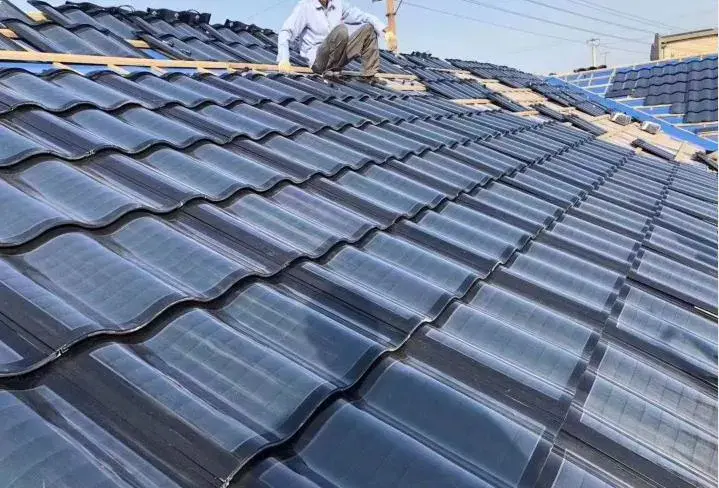
As the world shifts towards sustainable energy solutions, solar roof tiles are becoming increasingly prominent. By 2025, these innovative technologies are expected to significantly reduce carbon footprints, enhance energy efficiency, and promote eco-friendly building practices. This exploration delves into the environmental benefits of solar roof tiles and their potential to reshape our approach to renewable energy in urban landscapes.
Solar roof tiles, also known as photovoltaic (PV) shingles, are revolutionizing the way we harness solar energy. Unlike traditional solar panels, which are mounted on rooftops, solar roof tiles integrate seamlessly into the structure of the roof itself. This innovation not only enhances the aesthetic appeal of homes but also significantly contributes to reducing carbon footprints. As we look toward 2025, the environmental impact of solar roof tiles is expected to become even more pronounced.
The environmental benefits of solar roof tiles are vast and multifaceted. By converting sunlight into electricity, these tiles help reduce reliance on fossil fuels, thereby lowering greenhouse gas emissions. A study suggests that transitioning to solar energy could reduce CO2 emissions by up to 80% by 2030. This is particularly critical given the escalating concerns around climate change and its impacts on global ecosystems.
Moreover, solar roof tiles contribute to energy efficiency. They enable homeowners to generate their own electricity, leading to decreased energy consumption from non-renewable sources. In 2025, we can expect a surge in the adoption of solar roof tiles, driven by advancements in technology and increased awareness of sustainable practices.
The sustainability of solar roof tiles extends beyond their operational use. The materials used in their production are increasingly being sourced from recycled or sustainable resources. As manufacturers focus on minimizing their ecological footprint, innovations in material science will lead to more eco-friendly production processes. For instance, the use of recycled glass and silicon in solar tiles can significantly reduce the environmental impact associated with mining and processing raw materials.
By 2025, we anticipate that a larger percentage of solar roof tiles will be produced using sustainable methods, further enhancing their environmental credentials. This shift not only benefits the planet but also addresses consumer demand for greener products.
Another significant environmental impact of solar roof tiles lies in their ability to reduce the **urban heat island effect**. Urban areas often experience higher temperatures than surrounding rural areas due to human activities and infrastructure. Solar roof tiles can help mitigate this effect by reflecting sunlight and converting it into usable energy rather than absorbing heat, which traditional roofing materials often do.
As more homes and commercial buildings adopt solar roof tiles, we can expect a gradual decline in local temperatures, improving urban air quality and reducing energy costs associated with air conditioning. This benefit will be particularly important in densely populated cities as climate change continues to escalate.
In assessing the environmental impact of solar roof tiles, it is essential to consider their entire lifecycle—from production to disposal. Lifecycle assessments (LCA) evaluate the environmental effects of a product at each stage, providing a comprehensive view of its sustainability. As we approach 2025, improvements in the LCA of solar roof tiles are expected to showcase even greater benefits.
The end-of-life phase is particularly crucial. Many manufacturers are exploring **recycling programs** that allow old solar roof tiles to be repurposed, thereby minimizing waste. This circular approach not only conserves resources but also reduces the need for new materials, thereby lowering environmental impacts further.
The environmental benefits of solar roof tiles are closely tied to economic factors and policy support. As the demand for renewable energy solutions grows, we can expect government incentives and subsidies to play a pivotal role in advancing the adoption of solar roof tiles. By 2025, favorable policies may encourage homeowners to invest in these eco-friendly alternatives, ultimately contributing to a more sustainable future.
Additionally, the declining cost of solar technology will make solar roof tiles more accessible to a broader audience. As installation costs decrease and efficiency increases, more people will be able to take advantage of the **long-term savings** associated with solar energy.
Looking ahead to 2025, the environmental impact of solar roof tiles is poised to be significant. With advancements in technology, increased adoption, and greater awareness of sustainability, we can expect a substantial reduction in carbon emissions, improved energy efficiency, and enhanced urban environments. The combination of economic incentives and public support will further accelerate this transition, making solar roof tiles a cornerstone of modern sustainable architecture.
In conclusion, as we move towards 2025, the potential environmental impact of solar roof tiles is clear. By embracing this innovative technology, we can make strides toward sustainable living, reduce our carbon footprint, and create a cleaner, healthier planet for future generations.

Cost and Financial Benefits of Solar Roof Tiles in 2025
The Future of Solar Roof Tiles in the USA: Trends and Innovations for 2025
Top Benefits of Installing Solar Roof Tiles in Your Home by 2025
Comparing Solar Roof Tiles vs. Traditional Solar Panels: What to Expect in 2025
How Solar Roof Tiles Can Increase Your Home's Value in 2025
The Best Solar Roof Tile Brands to Watch in the USA for 2025
Government Incentives and Rebates for Solar Roof Tiles in the USA by 2025
A Comprehensive Guide to Choosing the Right Solar Roof Tiles for Your Home in 2025